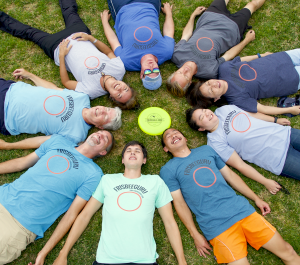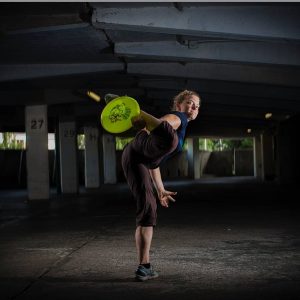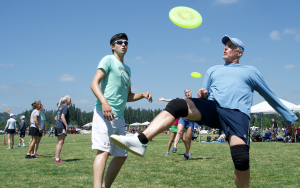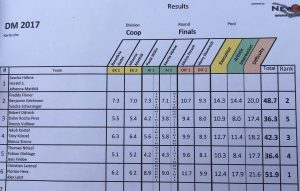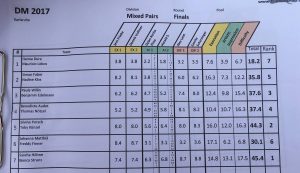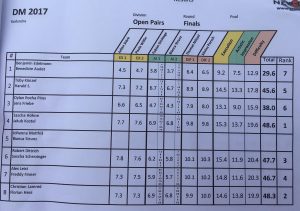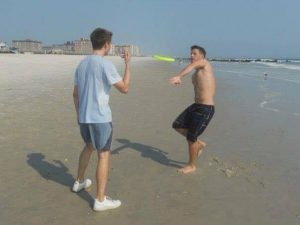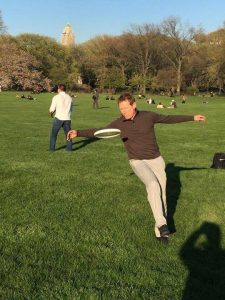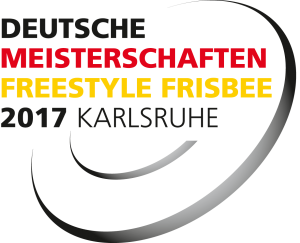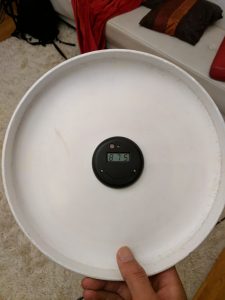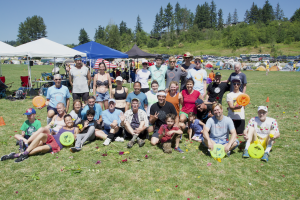 Potlatch is a long running mixed (co-ed) Ultimate event that is hosted by Disc Northwest in the Seattle area. Four years ago, Ryan Young teamed up with Disc Northwest to add a Freestyle event to the Potlatch schedule. Every year since then, the event has challenged Freestyler players to “think outside the box”, attracted the attention of many Ultimate players, and been an all around fun time for all. This year was no different.
Potlatch is a long running mixed (co-ed) Ultimate event that is hosted by Disc Northwest in the Seattle area. Four years ago, Ryan Young teamed up with Disc Northwest to add a Freestyle event to the Potlatch schedule. Every year since then, the event has challenged Freestyler players to “think outside the box”, attracted the attention of many Ultimate players, and been an all around fun time for all. This year was no different.
The scene at Potlatch: Imagine walking onto 60 acres of lush green grass, filled with Ultimate games covering 16 fields with two teams already involved in their games. Hundreds of ultimate players are everywhere, most in costumes representative of their team’s theme – and dragging their props with them between games from field-to-field. Camping tents are surrounding the perimeter of the entire venue. Amidst all this is a half-sized Ultimate field, carved out for the Freestyle Event. Tunes are blasting while jammers are pulling off heinous moves. Ultimate players walk by on their way to their next game and suddenly are taken aback by a chest roll or spinning kick brush. For Freestylers, just being in the middle of all this was a treat.
Potlatch had 27 registered Freestylers and several more who were just there for the jams. This year featured three events: 2 minute Open Pairs, a new event named Turbo Jam, and the always popular and famous Flower Round.
The Open Pairs judging system featured Ryan’s unique tablet based judging system that uses an XBox controller for input. There are two triggers on the controller. One trigger represents a heinous move, while the other represents a drop or other significant error. Ryan compares it with driving a car. As players get hot, the judges will pull the “gas” trigger and the score ramps up. If a player drops, the judges pull the “brake” trigger and the scoring slows down. An interesting result of this is that a drop in the middle of a routine hurts more than a drop in the beginning or at the end.
Players in this event got the message that they should “go big or go home”. And, that’s exactly what happened.
Taking third place were Lori Daniels and Jake Gauthier (me). A couple of mid routine drops held back our scores. However, we had some nice passing, a solid brush run, and a strong finish with a gitosis. In second place was the seed-busting team of Juliana Korver and Emma Kahle. These player’s styles complemented each other nicely with tight controlled flat work and an intense brushing “GRRRRR” factor that propelled their scores in the eye’s of the judges. The first place team of Ryan Young and James Wiseman was untouchable in terms of level of difficulty with almost every catch preceded by a double spin. Their individual moves were also executed with confidence and explosiveness. And, though playing spontaneously, they hit music ques repeatedly. Perhaps the most telling sign that they were doing so great was that a large group of Ultimate players stopped and watched their entire routine, cheering the entire time. Scores below.
The Turbo Jam event is an interesting twist on individual move competition format. Similar to an Open Pairs event, players team up with each other and then teams are split into A and B pools. From here, the event is very different than an Open Pairs event. Players on each team in a pool are set as either A or B. Being an individual move competition, each player in the pool goes through a “round robin” format: Player A for Team 1 gets 1 throw, and then Player A for Team 2 gets their first throw, and so on.
Play order is determined as follows: Teams in the pool are ranked as a whole; let’s say 1, 2, 3, 4. So, player 4B goes first, receiving a throw from their teammate, 4A. Then 3B receives from 3A, 2B from 2A, and so on, until every B player has attempted their highest scoring moves; then the rotation goes for the A players receiving throws from their teammates and trying their tricks; then switch back to the B teammates, and then to the A teammates. The round for the 4-5 pairs teams goes for 25 minutes. When the clock runs out, the current rotation finishes and then play is completed. Within the 25 minutes, each player from each pairs team will have had about 6 attempts at a turbo move.
Judges are looking exclusively for difficulty. If the player drops, the highest score is 10. If a player catches, the highest is 50. At the end of play, each player keeps only their highest score. To get the team’s score, player’s highest scores are added together for a total 100 points possible per team. The top 2 teams from each pool move to the finals.
As if doing a turbo move individually wasn’t enough challenge, Ryan required that each player only have three touches to the disc prior to a catch, with none of the touches being a center delay. Rim delays were acceptable, as were nail maneuvers that brought the disc flat briefly – but no center-delaying. Air-brushing, tips, cuffs, and body-rolls were counted as one touch. Players with 4 touches or more prior to a catch attempt were not scored.
These rules seem limiting at first. However, they proved to be quite enjoyable as players had to rethink their approach to an individual competition. Players quickly figured out what types of trick to focus on. One option employed by James Wiseman was to do three spinning restricted pulls into a spinning restricted catch. He earned several scores of 50 with this approach. Ryan Young started a lofting throw, did several brushes and then went for a very risky “early retirement” catch (bigger than a vacation) but dropped when he hit the ground. Still, he had other moves that earned him a 48. Matt Gauthier decided to go for a score of 50 off of all of the throws he received, eventually able to coax-in a double spinning UTL hammer pull and then using the next two touches for regaining control before the catch.
All-in-all, The Turbo Jam was a success. It was fun, very challenging, kept things fast-paced, and brought out some huge combos that might not be seen in a standard Open Pairs event. Scores below.
And, of course we can’t forget the Flower Round. Teams of 3 are randomly created from a hat. Then they play for 3 minutes each. But, instead of judging, the audience gets to throw flowers onto the field whenever the team gets hot. This makes for a low pressure, go-for-it type round. Many ultimate players stopped to watch and several times, entire teams participated in throwing flowers! One of the more memorable moves was when James called for Ryan to hit a triple barrel gitis, at which point Ryan’s smile got a little bigger and he went for it, hitting it perfectly. Flowers flew and the crowd cheered.
Potlatch this year was an incredible event that included amazing jams, great weather, audience engagement, Spam musubi, heinous competition, and fun fun fun for all.
Thank you so much, Ryan Young for putting on this event for the players and ultimate community, many of whom were in awe of what they were watching! If you have not attended a Potlatch before, add it to your schedule for next year.
Scores
Open Pairs
- Ryan Young James Wiseman 3706.905 2718.458 6425.363
- Emma Kahle Juliana Korver 2653.87 2520.37 5174.24
- Jake Gauthier Lori Daniels 2380.459 2273.05 4653.509
- Matt Gauthier Lisa Hunrichs 2347.91 2087.88 4435.79
- Johnny Trevino Angelo Trevino 1234.681 2630.23 3864.911
- Charles Logan Char Powell 745.8279 1940.43 2686.2579
- Cindy St. Mary Tony Pellicane 1176.384 1384.355 2560.739
- Mike Galloupe Mike Slaska 504.79 1599.03 2103.82
- Mary Lowry John Titcomb 257.99 1408.335 1666.325
- Dan Yarnell Bob Boulware 299.43 516.76 816.19
- Doug Korns John Anthony 127.85 506.48 634.33
- Michaela Galloupe Aiden Slaska 178.15 387.16 565.31
Turbo Jam
Semi Pool A
- Ryan Young James Wiseman 48 50 98
- Lisa Hunrichs Cindy St. Mary 46 43 89
- Jake Gauthier Lori Daniels 49 34 83
- Aiden Slaska Angelo Trevino 25 29 54
Semi Pool B
- Doug Korns Matt Gauthier 25 50 75
- Mike Galloupe Johnny Trevino 32 27 59
- Tony Pellicane Emma Kahle 27 24 51
- Juliana Korver Charles Logan 25 25 50
- Bob Boulware Dan Yarnell 10 47 47
Final
- Ryan Young James Wiseman 40 48 88
- Johnny Trevino Mike Galloupe 30 35 65
- Doug Korns Matt Gauthier 20 40 60
- Lisa Hunrichs Cindy St. Mary 35 25 60
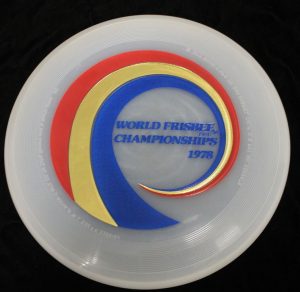 In 1977, more State Championship tournaments got their start, specifically Arizona and Tennessee. The delay move rapidly replaced controlled tipping as the foundation of a freestyle routine. (It was either adopt the delay, or never catch up to Joey and Richie.)
In 1977, more State Championship tournaments got their start, specifically Arizona and Tennessee. The delay move rapidly replaced controlled tipping as the foundation of a freestyle routine. (It was either adopt the delay, or never catch up to Joey and Richie.)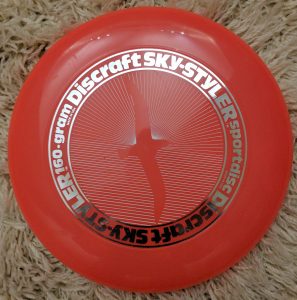 Dave Marini started up the Freestyle Players Association in 1978, and freestyle became a sport of its own. The sport of Freestyle attracted a new generation of players such as Rob Fried, Doug Simon, Roger Meier, Peter Laubert, Krae Van Sickle, Jeff Felberbaum, John Dwork, Brad Keller, and Donnie Rhodes from New York City; and John Jewell, Brian and Matt Roberts from Los Angeles. Also new to the scene was Kevin “Skippy Jammer” Givens who would become highly influential mentoring numerous future champions. The sport also saw the emergence of the “Coloradicals” featuring Bill Wright, Doug Brannigan and Rick Castiglia. On the women’s side of things, New York’s Sue Strait and Jane Englehart set the standard and were closely rivaled by G Rose and Laura Engle. Seattle’s Mary Lowry also began playing around this time and would eventually become one of the most influential women’s players of all time. Seattle’s Randy Silvey got his start during this era. Discraft’s introduction of the Sky Styler disc in 1980 presented an option for Freestylers and became extremely popular as a freestyle disc, eventually replacing the 80 mold as the de facto disc of choice. The Sky Styler weighed in at 160 grams, slightly less than the 80 mold. While it had a smaller flight plate and delay surface area, it had a deeper rim which allowed for superior brushing, rolling, rim work and wind play. It was also easier to catch than the Wham-O 80 mold. Tom Schot’s World Disc Games in Santa Cruz got its start during this period and further fueled the growth of freestyle.
Dave Marini started up the Freestyle Players Association in 1978, and freestyle became a sport of its own. The sport of Freestyle attracted a new generation of players such as Rob Fried, Doug Simon, Roger Meier, Peter Laubert, Krae Van Sickle, Jeff Felberbaum, John Dwork, Brad Keller, and Donnie Rhodes from New York City; and John Jewell, Brian and Matt Roberts from Los Angeles. Also new to the scene was Kevin “Skippy Jammer” Givens who would become highly influential mentoring numerous future champions. The sport also saw the emergence of the “Coloradicals” featuring Bill Wright, Doug Brannigan and Rick Castiglia. On the women’s side of things, New York’s Sue Strait and Jane Englehart set the standard and were closely rivaled by G Rose and Laura Engle. Seattle’s Mary Lowry also began playing around this time and would eventually become one of the most influential women’s players of all time. Seattle’s Randy Silvey got his start during this era. Discraft’s introduction of the Sky Styler disc in 1980 presented an option for Freestylers and became extremely popular as a freestyle disc, eventually replacing the 80 mold as the de facto disc of choice. The Sky Styler weighed in at 160 grams, slightly less than the 80 mold. While it had a smaller flight plate and delay surface area, it had a deeper rim which allowed for superior brushing, rolling, rim work and wind play. It was also easier to catch than the Wham-O 80 mold. Tom Schot’s World Disc Games in Santa Cruz got its start during this period and further fueled the growth of freestyle.


